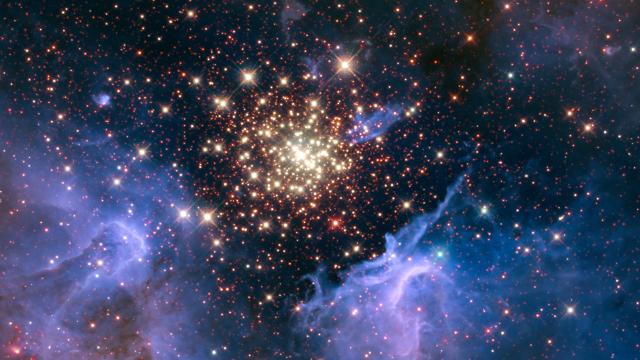You’re probably aware of some of the challenges of sending astronauts to space. Getting to space, that’s one for sure. But there’s another insidious effect you might not think of: Tissue damage from radiation.
A source of galactic cosmic rays (Image: NASA/U. Virginia/INAF, Bologna, Italy/USRA/Ames/STScI/AURA)
Space radiation comes from all over. There’s more potential harm from the Sun’s rays, unshielded by the Earth’s atmosphere, but also from cosmic rays hailing from the depths of space. Unfortunately, we can’t really recreate this radiation environment on Earth to test its effects on biological tissue — rather, we rely on a few beams of a few different high-energy particles to simulate it. A team of scientists have an idea for a better way to recreate space radiation to test tissue damage — and it shouldn’t be too difficult. After all, the solution can be made from plastic.
“Part of the elegance is that it’s so simplistic,” Jeff Chancellor from Texas A&M University told Gizmodo. “It’s time proven physics that has been pretty well validated experimentally.”
Space radiation isn’t just a few subatomic particles or high-energy light rays. It consists of a whole slew of fast-moving charged elements from the periodic table. If these high-energy nuclei penetrate spacecraft, they can cause physical harm to the astronauts inside, either by damaging tissue or the DNA molecules themselves.
Creating accurate simulations of space radiation here on Earth would help remove some of the uncertainties we deal with today. After all, there are only a few individual elements used to test space radiation today, rather than a whole spectrum.
“Before, they took a giant rock, threw it, and hope they did something cool,” Helmut Katzgraber also from Texas A&M told Gizmodo. “Now we’re using a computerised chainsaw.”
The method Chancellor, Katzgraber and their team propose involves putting an engineered block of some material (they say plastic) in front of a single beam of heavy atomic nuclei. The block would split the beam up into many different elements of different energies, and could be tuned to create the right energy and particle spectrum to simulate outer space.

Image: Chancellor et al
All they have is a model right now, and don’t have the funding for the actual block, but they’re confident in their model, which they proposed in a paper on the physics arXiv preprint server. At least one other researcher thought the method was feasible and reasonable. Ann Kennedy, professor emeritus in radiation oncology at the University of Pennsylvania, “found it to be a very interesting, novel approach for simulating the space radiation environment through use of a new model system that allows evaluation of the intravehicular radiation spectrum,” the stuff that could harm astronauts inside the spacecraft.
Kennedy would like to see more data, however. She noted that the study doesn’t include neutrons and other non-charged particles in its calculations. But the paper says that data on the abundance of these particles isn’t available from spaceflights. I’ll point out that NASA does have chips on the ISS currently taking a look at the radiation environment (I played with one of them).
“Perhaps a follow-up article by the authors could include a comparison of the [energy] spectrum both with and without the neutron component considered,” she said.
Other teams are working on recreating space radiation in the lab too, such as one European team who hit a metal foil with a powerful laser. But this only created different energies of electrons or protons, not the heavier atomic nuclei proposed by Chancellor and Katzgraber.
Ultimately, if we want to go to Mars, we’ll have to understand the effects of this radiation in one way or another. And, of course, that’s going to take money. “We have validated this whole concept,” said Katzgraber. “Now building the block with the cuts would require an investment from NASA, SpaceX or another corporation interested in doing so.”
[arXiv]
